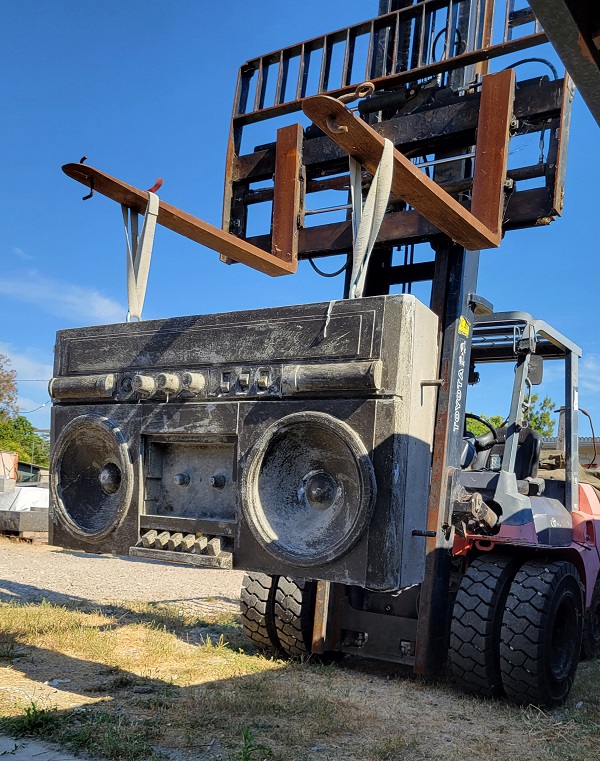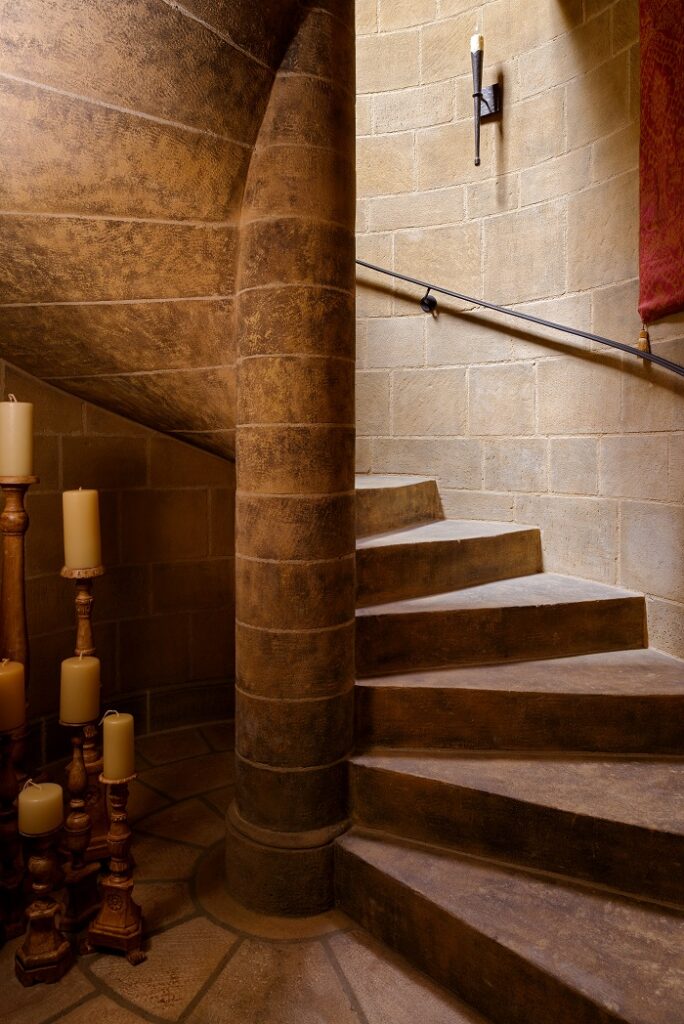Pascal Faivre, Stonemason, Artist, and Musician.
Pascal Favire is a stonemason, artist, and musician whose craft runs deep in his lineage. His family—father, grandfather, great-grandfather and even further back—were all stonemasons in France for at least 800 years. Faivre began apprenticing alongside his father at the age of seven, learning the traditional French masonry arts. He emigrated from France in 1990 and soon after started his company A L’Ancienne Imports. Faivre lives in the town of Sonoma with his wife—musician and activist Dmitra Smith—where he carries on his family’s legacy, creating both private commissions and original art. He and Smith also play in the punk bands Half People and Ex’s with Benefits. Of his ancestors, Faivre says, “They were all stone carvers. They were all musicians. And so am I.”
Kary Hess: You began working with your father, who was a stonemason, when you were only five, and apprenticed with him at seven. Was working with stone inevitable? Did you always know you would pursue it?
Pascal Faivre: My dad would say we’re going to fix this arch in this castle over there, and that’s what we did—I didn’t think about it. But I didn’t want to do that work. I tried to escape it by coming to America when I was 22 to have my own adventure. I came with my guitar, and I was going to play in bands. But when you come into a capitalist country, if you don’t have money, it’s not going to work. So I started doing a little [stone] work here and there. One day, I’m 24, and a guy says, “This architect is looking for somebody to install this fireplace from France, and they don’t know how to do it. Could you show the mason?”

I’d seen these fireplaces many times already and I had [installed them] during my youth. I knew how to do it without even thinking. So I went and laid it out on the ground, and the mason’s like, “Okay, you’re gonna do it.”
So that’s how it started. Then I worked everywhere. I went to New York. I went to Beverly Hills. Then we had our son, and I was like, I’m not going to be on the airplane all the time. That’s when we moved to Sonoma from San Francisco because I had so much work here. I started my business here in ’96, and it’s been almost 30 years now.
KH: In what way has your work evolved over the past decades?
PF: I’m an expert now at what I do since I’ve been doing it for so long. I always stayed true to what I wanted to do and respected the work. But I still have so much to learn—the more you know, the less you know.
KH: How do you see your work as part of a larger tradition of stonemasonry and sculpture, and how are you carving your own path (so to speak) with your own business and artwork ?
PF: You know, I don’t see it as a business anymore. Now I only do projects I want to do. I’m very specific—I do old-world traditional authenticity; I thrive through authenticity.
Authenticity is the windows relating with the size of the wall. There’s so many little things to make it look right. So if a house is built out of stone, you’re not going to put a window right by the corner, knowing that the wall is supposed to be three feet wide. In the old world, they would also never put a window in the middle of the wall because you leave some space to have an armoire, because there was no closet, so they put the window off to the side.
There are closets now so that doesn’t really matter, but for the aesthetic, you’ve got to go back to this world. So I have a process of putting that story into [the design]. Like with a movie, the audience doesn’t know the backstory; it just makes sense. They don’t need to know the backstory.
My dad was really poetic with it. He was really rough with his work; he’d carve a stone with a screwdriver. He was really frantic and super messy. But his poetry for the beauty of it was amazing. So he really passed that on to me. At the same time, you learn about the golden ratio, every mathematician will take the dimension of everything, fingers, hands, nose, and then they find an equation for everything, like how seeds relate to the fruit. I don’t have to pull out my calculator when I do something because I know that I have it in me. You have it in you. You just have to tap in. What’s a beautiful shape? How do you cut a line? And where do you cut it so it’s balanced? You don’t go in the middle— the middle goes nowhere. Take, for example, the Nike swoop, it’s got that animation to it; its design is animated.
KH: Are there particular types of stone you love to work with?
PF: That’s definitely limestone—limestone from my region, the Jura Mountains [in France]—because I grew up with it. It’s a very old stone—like 200 million years. And it’s one of my favorite things to work with a product that’s that old. It used to be at the bottom of the ocean, and at some point, Pangea pushed it up and formed mountains with it. And so we dig those stones out. I like limestone because, first, there’s so much variety; limestone has every color, every density—marble is limestone. And, you can get something very soft that you can just carve with a piece of metal. I like that. I like the idea that when you carve something, it could last for another 200 million years. I love that part. It’s not like a piece of wood or a canvas. You could bury it, and somebody could dig it out in 10 million years.
KH: Most of your work is for private clients, but is there a local commissioned work people can see?

PF: I re-did the stone bridge in Bartholomew Park. It was an existing bridge made by the Chinese in the late 1800s and it was starting to crumble. So I dismantled a good half of it and rebuilt it, and now it’s beautiful. I’m really happy with this job.
KH: Your work spans both fine stonemasonry and fine art—how do these two practices inform each other? Is there a shared philosophy that connects them?
PF: My trade is stone masonry. And my love is music and musicians. And I love the old world of music. So I like to cross those over. Some of my art, like the amplifier sculpture, is made out of stone, but it’s to please a musician. With my artwork, I don’t have all the tools the stone carver has so I’ll often use stone mason tools. I don’t do fine carving. My dad taught me that you can do anything with anything. And I believe that. I don’t think you need to be completely equipped to do something. So my art is still rough. It’s still naive, in a positive sense of the term, with all the flaws that it can have. To me, that’s important, I don’t want to try to fix them. I’m pushing flaws, actually. I’m pushing for mistakes. With my art, when I do something and I feel like I’m going to mess up, I purposely mess it up. I push it. And I’ve discovered so many things by doing that.
KH: That’s really interesting—tell me more about that.
PF: When you lean into flaws, suddenly it looks weird. It’s weird because it’s out of context. But then I think, what if the whole thing was like that? And then my next art piece will be all like that.
KH: Do you have advice for other artists and craftspeople?
PF: I don’t take myself seriously, but I’m serious about my work. Like Mozart said, “I am very arrogant, but I can assure you my music is not.” It’s kinda like that. I respect what I do. I respect the idea. When the idea comes and I decide I’m gonna do that idea then now it’s my friend. And I will respect it. Because if you don’t, you go away and somebody else does it.
A L’Ancienne Imports
Traditional French Masonry Arts
(707) 996-2550
Ex’s with Benefits

